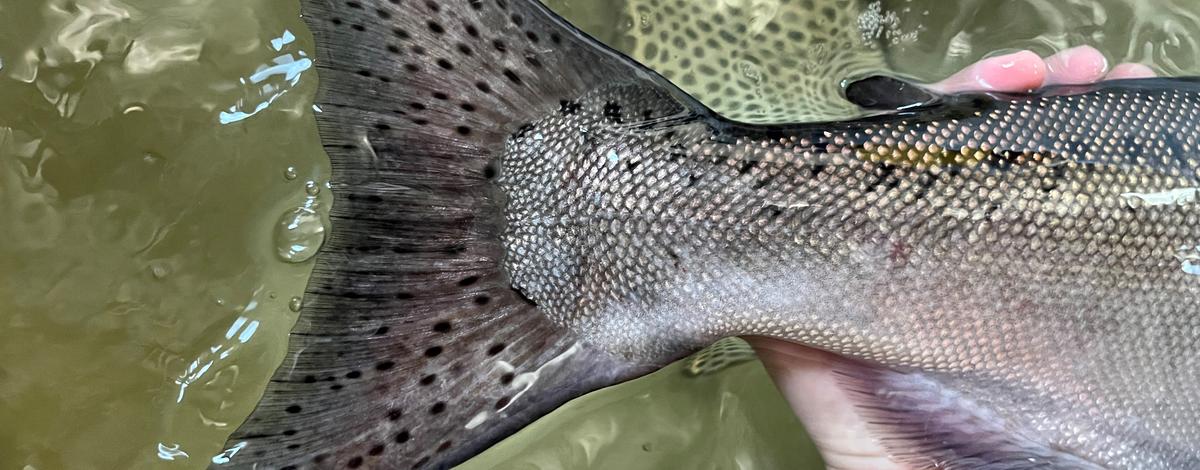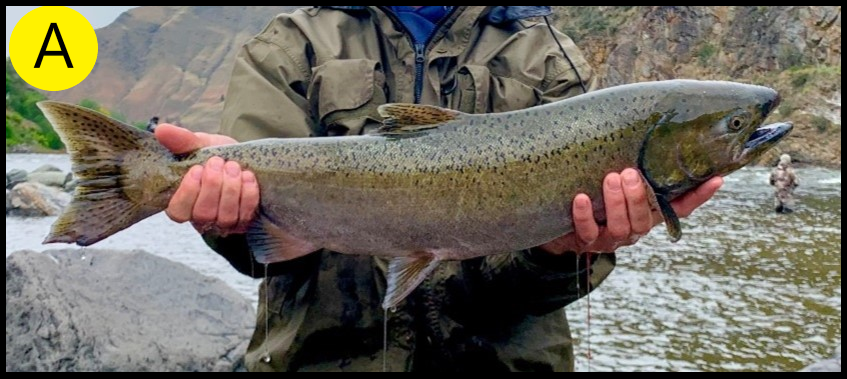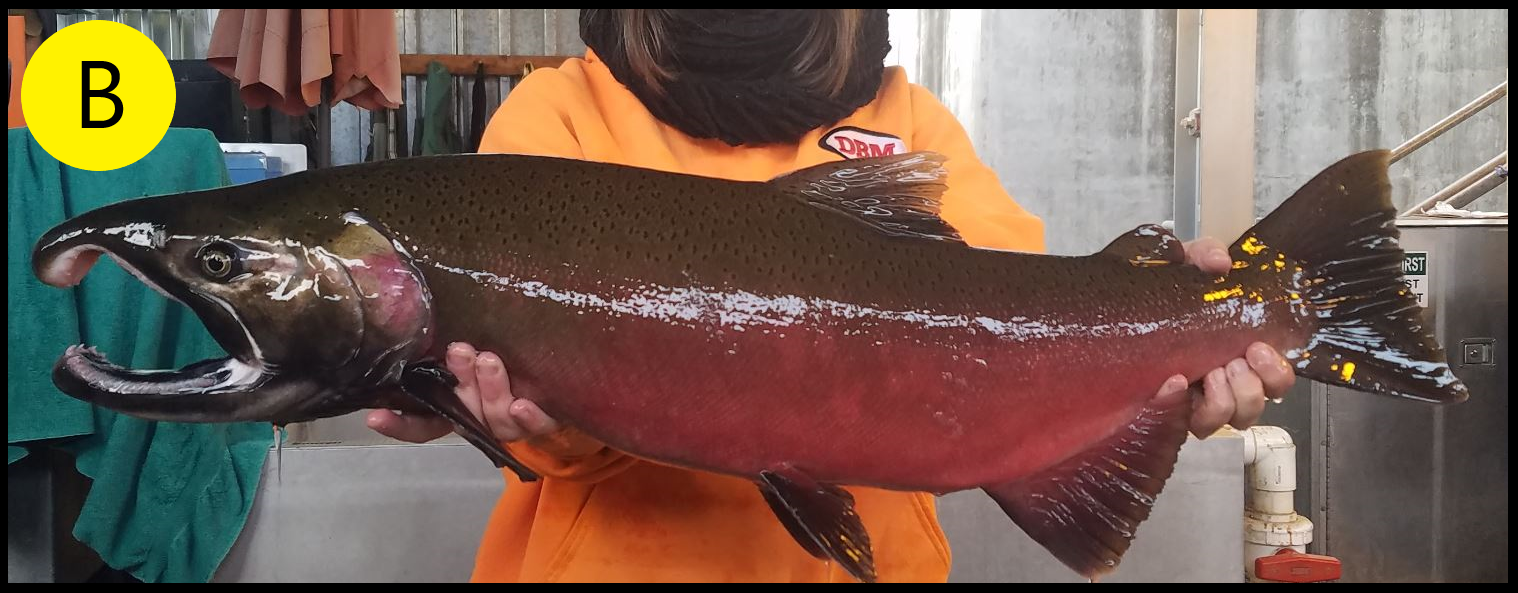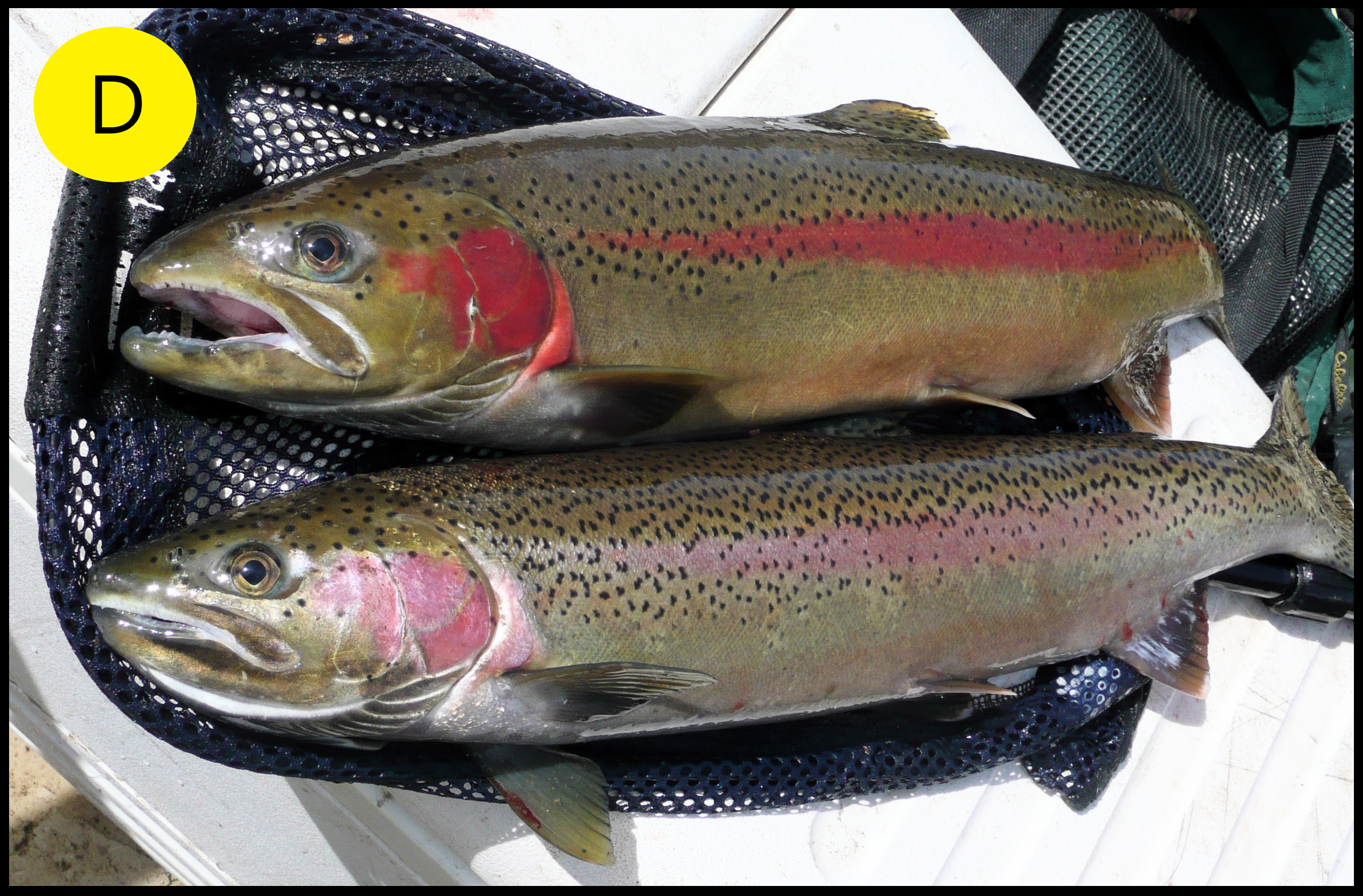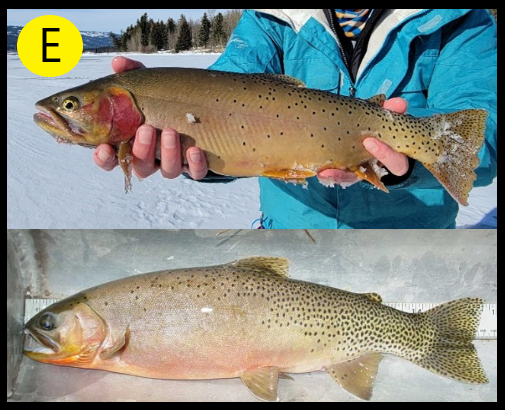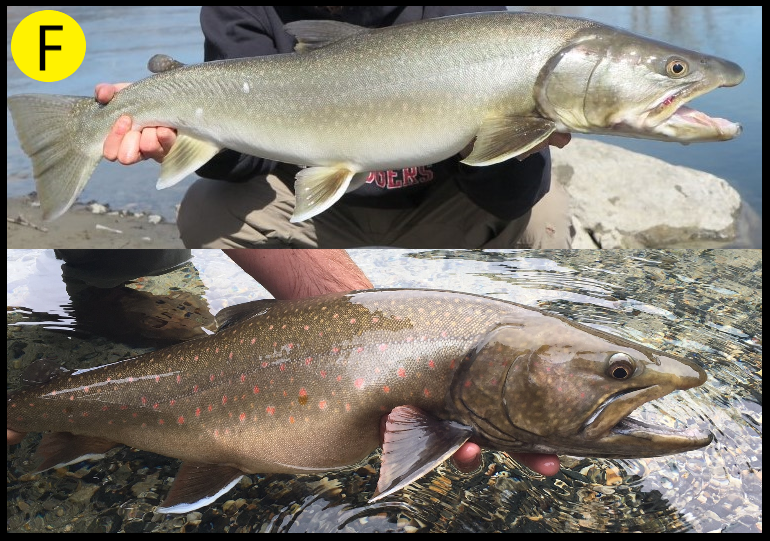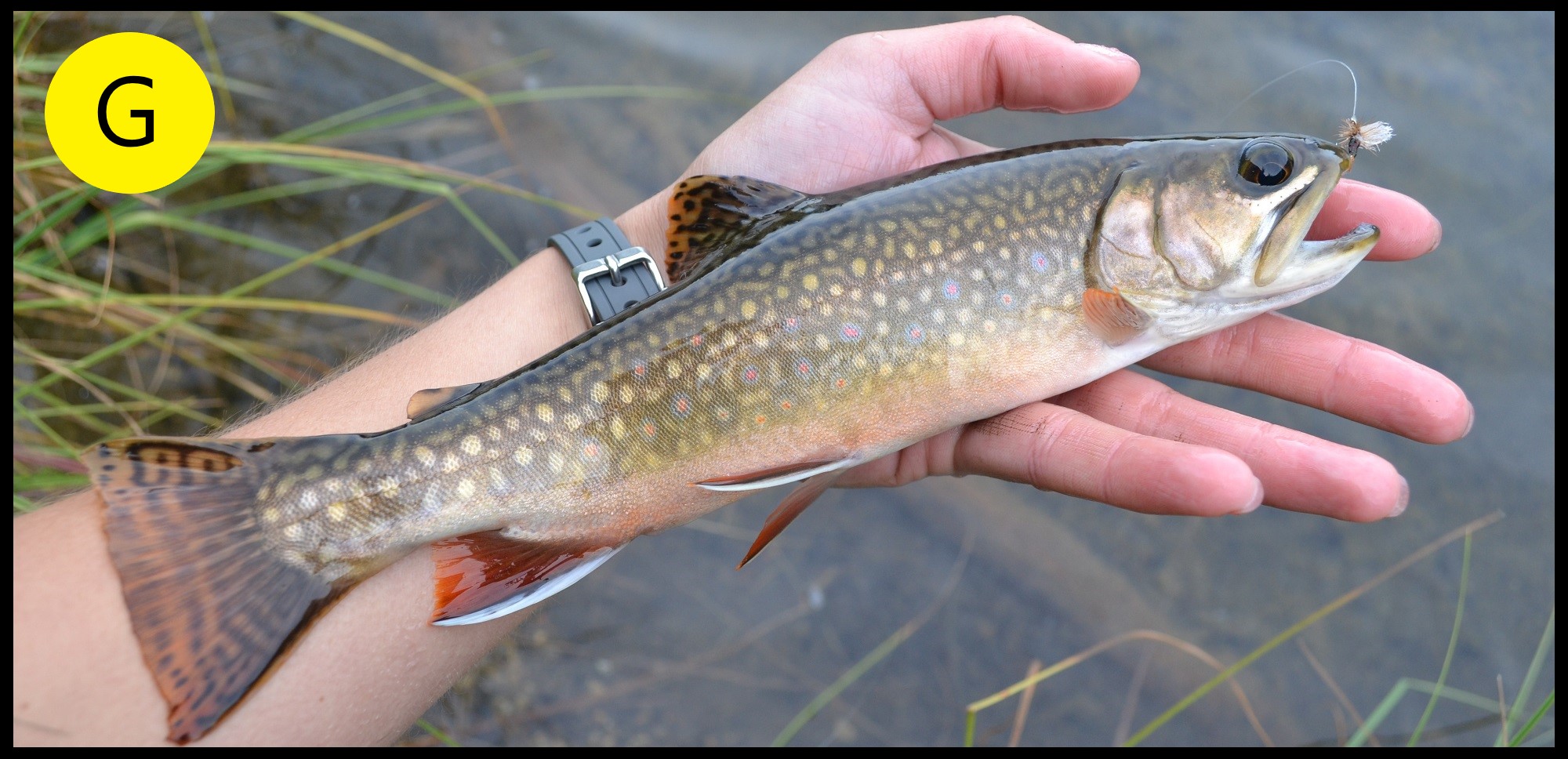Think you’ve got ‘em all? Check your answers with the descriptions below to see if you’re truly the master of spotting salmonids…
Note: salmon undergo significant color and body shape changes during their spawning migration from saltwater to freshwater; the characteristics described below refer to their freshwater mature adult phase coloration, which is what you would expect to see in Idaho.
A) Chinook Salmon (Scientific name: Oncorhynchus tshawytscha)
- You can identify a Chinook Salmon by continuous dark spots on the top half of their body from their head to their tail, and spots are present throughout both lobes of the tail. These fish also have a black mouth with a black gumline. Body color ranges from olive green to brown: the females are slightly lighter in color than the males, and the males will sometimes have maroon/red on their belly and sides.
- Fun fact: Chinook Salmon are the largest of the Pacific salmon species and are also referred to as King Salmon.
B) Coho Salmon (Oncorhynchus kisutch)
- Coho Salmon look similar to Chinook Salmon and they can be challenging to tell apart, but not impossible! Coho also have continuous dark spots on the top half of their body from their head to their tail, but they only have spots on the upper lobe of their tail, the lower lobe is plain. Coho have a black mouth with a white gumline. Body color ranges from dark brown to maroon/red.
- Fun fact: Coho are native to Idaho and were extirpated years ago, but now, thanks to reintroduction efforts, they are making a comeback in our great state! Coho are also referred to as Silver Salmon.
C) Sockeye Salmon (Oncorhynchus nerka)
- Sockeye Salmon are a little easier to tell apart from Chinook and Coho. Sockeye have no distinct spots and have a white mouth with a white gumline. Body color is a show stopper: solid bright red body and a green head, gorgeous! You may also encounter Kokanee Salmon in Idaho, which looks very similar to Sockeye, but are landlocked and do not migrate to the ocean.
- Fun fact: The Snake River Sockeye Salmon run has the longest freshwater migration (about 900 miles) and the highest elevation gain (6,547 feet) of any Sockeye population in the world! Sockeye Salmon are also referred to as Red Salmon.
D) Steelhead (Oncorhynchus mykiss)
- Steelhead have evenly spaced dark spots throughout most of their body and onto their tail. Body color ranges from dark green to pale silver green with a distinct pink or red stripe down their side and a pink or red patch on their cheek. Their colors will usually intensify during their spawning season in the spring from mid-April to late June. Steelhead look very similar to Rainbow Trout but are usually much larger in size because they migrate to the ocean for increased food opportunities.
- Fun fact: The catch-and-release Idaho state record for steelhead was recently broken in October 2023 – the lucky angler caught a whopping 41-inch steelhead! (New catch/release record steelhead landed | Idaho Fish and Game)
E) Cutthroat Trout (multiple Oncorhynchus species)
- Cutthroat Trout are sometimes confused with Rainbow Trout, but their dark spots are sparse near their head and most spots are heavily concentrated towards their tail. Cutthroats earn their name by the bright red or orange slash on the underside of their chin. Body color is variable depending on the species of cutthroat and can range from pale gray-green to yellowish brown, with red or orange on their bellies during spawning season. Don’t be fooled! – Rainbow Trout x Cutthroat Trout hybrids (known as “cutbows”) are also common in Idaho and can show characteristics from both species. So, if the trout you’ve caught has an orange chin slash, more evenly distributed spots, and some white-tipped fins, then it is likely a hybrid.
- Fun fact: Several previously well-known subspecies of cutthroat trout have been recently reclassified into four different species: Coastal, Westslope, Lahontan, and Rocky Mountain cutthroat trout. Although their taxonomic classification has changed, they still share the same identifying characteristics listed above when comparing them to other salmonids.
F) Bull Trout (Salvelinus confluentus)
- Unlike all the species above, Bull Trout have light spots on a dark background. They have no spots on their dorsal fin, which is key to telling them apart from a Brook Trout or other salmonids. Bull Trout can also be identified by a bright white leading edge on the front of their pectoral and pelvic fins. Their bellies can turn orange during spawning. Bull Trout also look similar to Lake Trout, another char species in Idaho, but Lake Trout have a deeply forked tail and Bull Trout do not.
- Fun fact: Bull Trout are listed as Threatened under the Endangered Species Act and are therefore catch-and-release only. Since Bull Trout have no black markings on their dorsal fins, an easy saying to remember while fishing is “no black - put it back!”
G) Brook Trout (Salvelinus fontinalis)
- Brook Trout are challenging to tell apart from Bull Trout (especially when they are small) in that they share these characteristics: light spots on a dark background, white leading edge on their pectoral and pelvic fins, and red or orange bellies during spawning. However, they have key differences that are important to remember, because Bull Trout are protected and Brook Trout are not. So, let’s seek the spots! First, Brook Trout spots extend onto their dorsal fin in a mottled pattern, whereas Bull Trout have a plain dorsal fin. Second, Brook Trout have distinct “squiggly worm tracks” on their back, called vermiculation, whereas Bull Trout do not have this spot pattern. Third, sometimes Brook Trout will have blue halos around a select few spots on their side, whereas Bull Trout have no blue halos.
- Fun fact: Brook Trout are native to eastern North America and are the state fish of nine states – not surprisingly, most of them are eastern states!
So…how’d you do? Whether you aced it or have some serious studying to do, be sure to check out Idaho’s fishing regulations (Fishing Seasons and Rules | Idaho Fish and Game) before you head out on the water, you never know which of these species you may encounter. This is not an all-inclusive list of Idaho’s salmonids, but it’s a good starting point to go forth and impress your friends with your newly acquired fish ID knowledge. And remember, always seek the spots!

